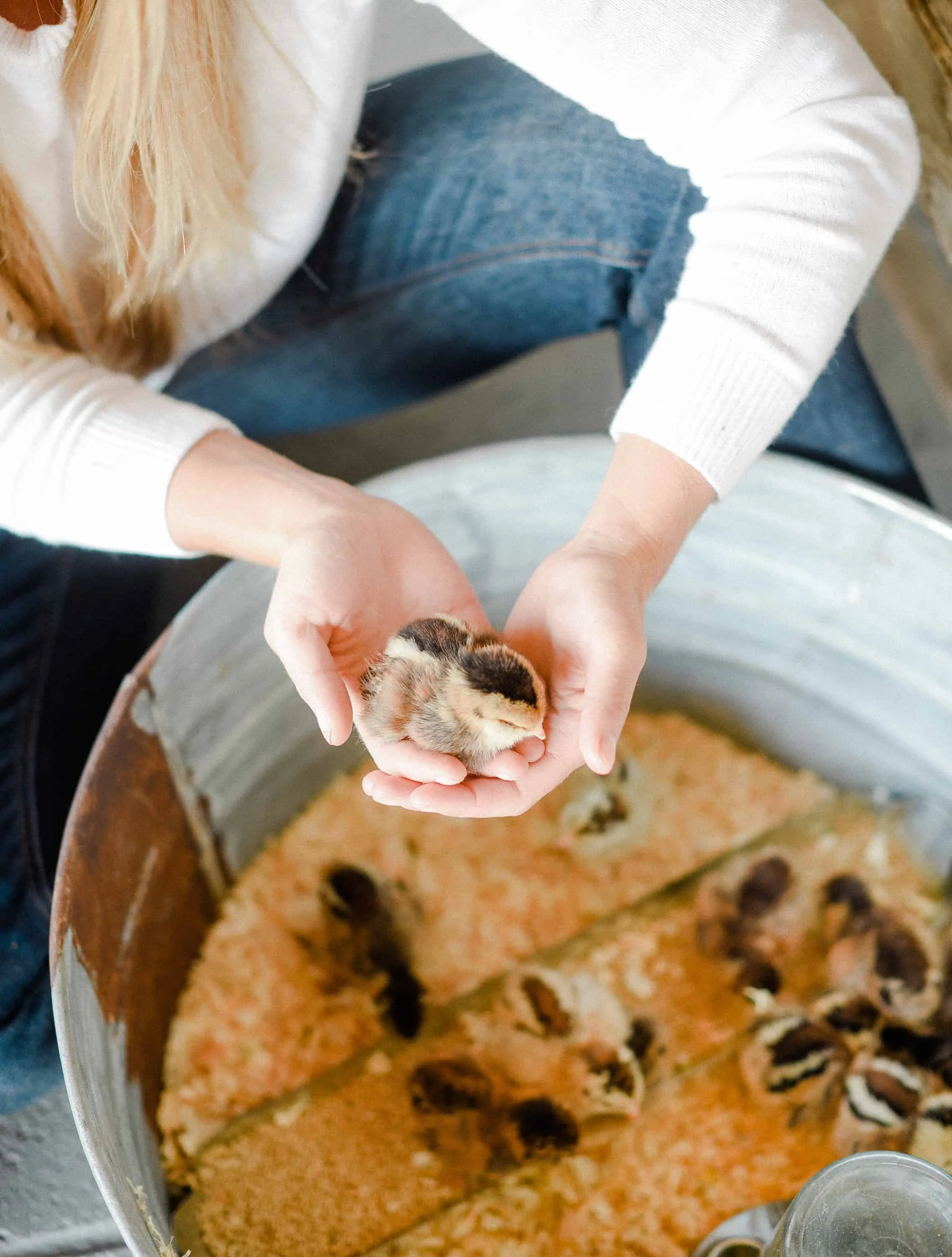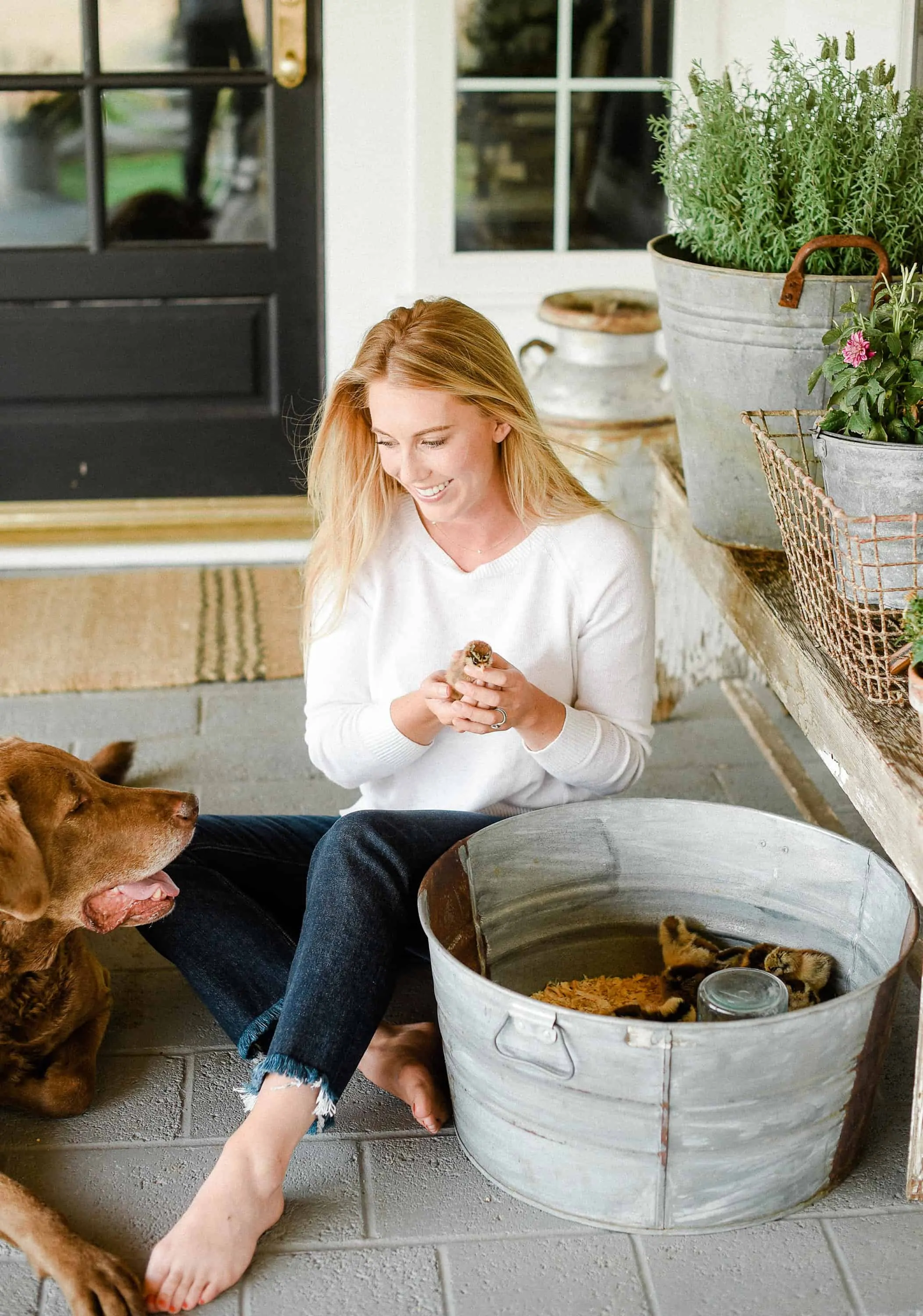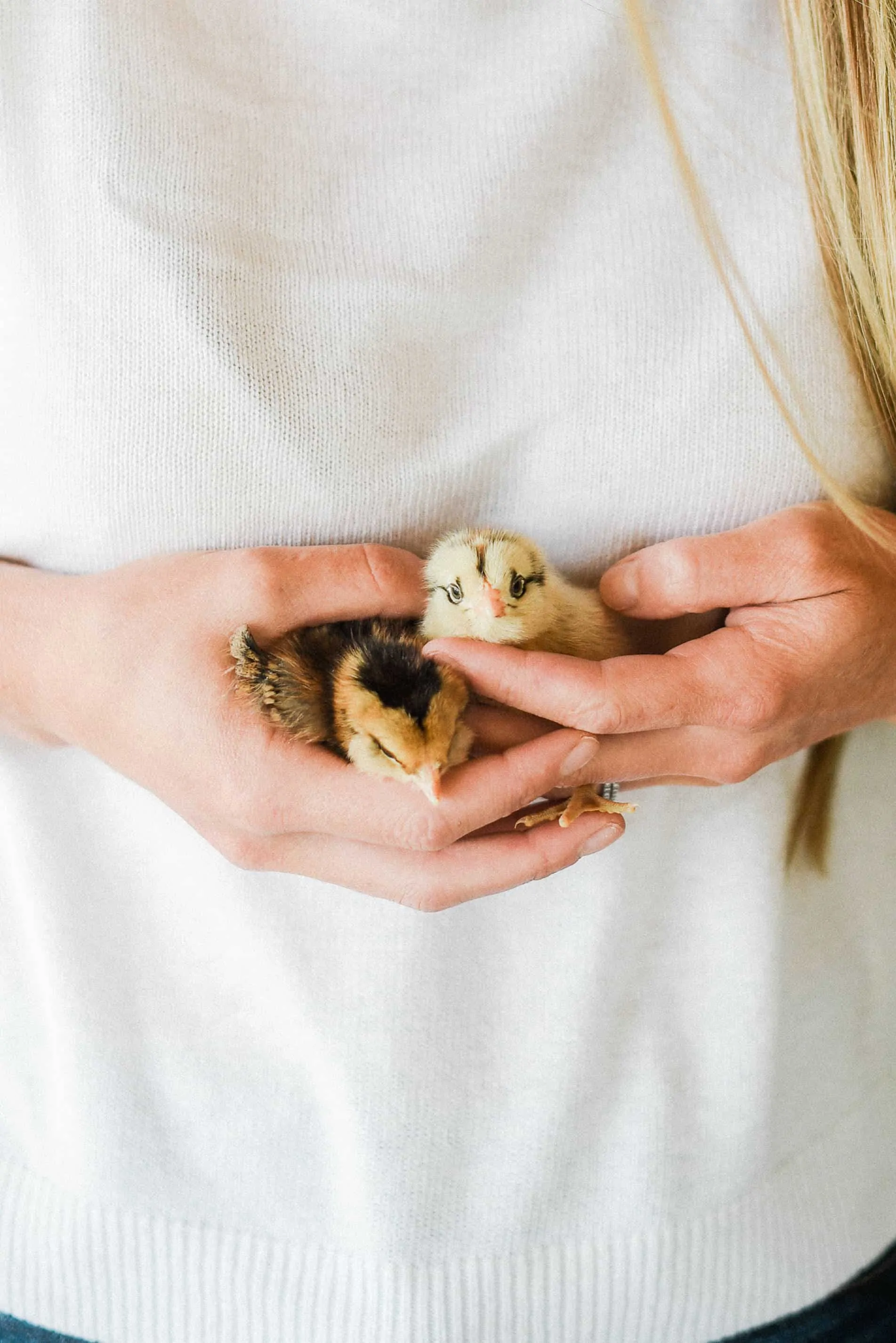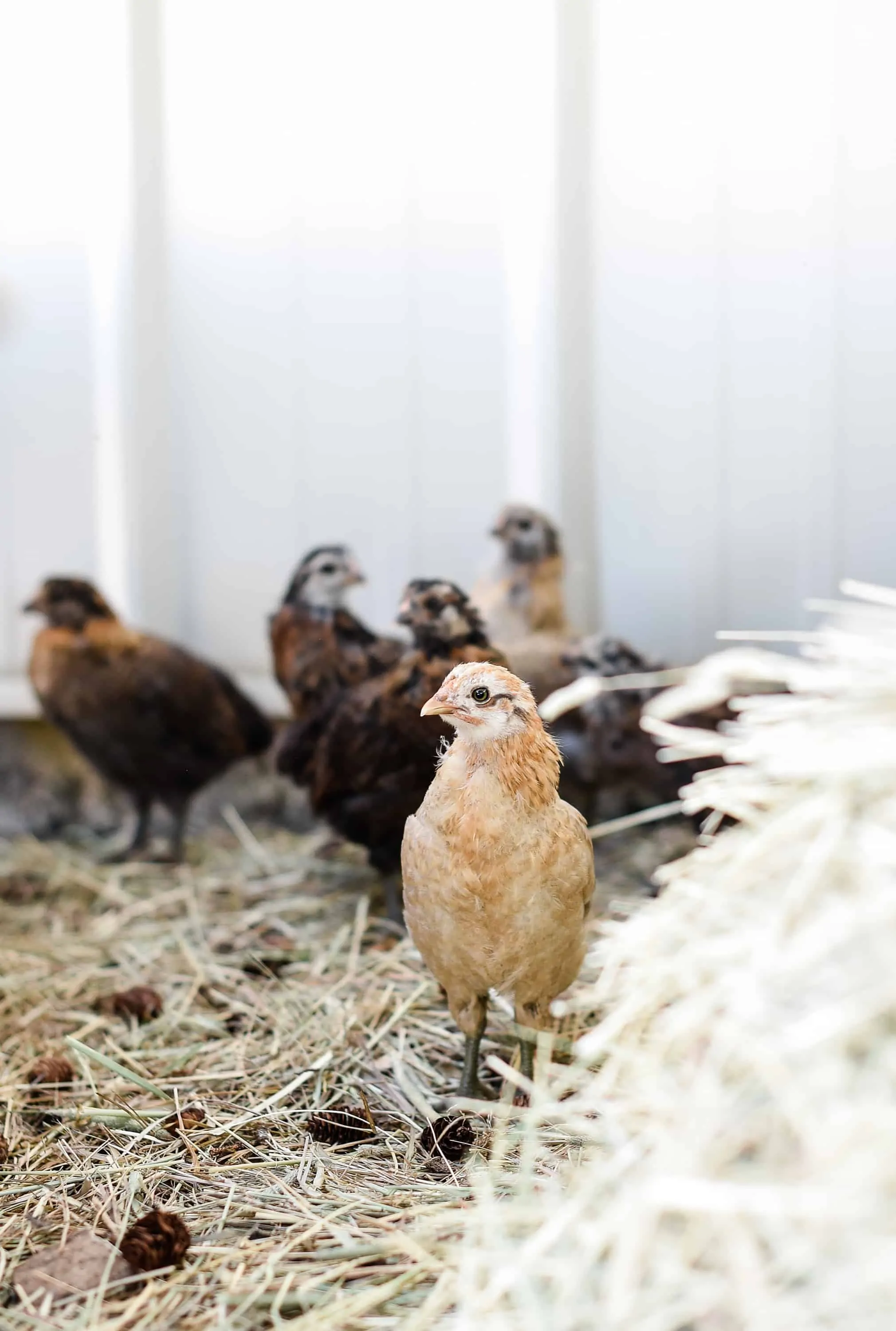If you plan on raising backyard chickens, chances are, you’ll start with young chicks. Here is everything you need to know to begin your backyard chicken journey – starting with raising baby chicks!

Table of contents
How to Raise Chicks: Growing Your Own Backyard Flock!
Raising your own fluffy chicks is easy and fun! Don’t be intimidated by the idea of raising baby chickens – they are much more carefree than you’d think! Let’s get started with this beginner’s guide on how to raise chicks.
What Do Chicks Need?
Food & Water
Chicks need chick starter feed and access to fresh water at all times. You can find high-quality feed at your local feed store or farm suppliers. Some chicken keepers add a little apple cider vinegar to their chick’s water to support digestion.
Make sure to provide a chick waterer, as open dishes can lead to drowning or contamination. Chicks also benefit from chick grit, which helps them digest their food properly.
Heat
Chicks require a heated brooder to stay warm. In nature, a mama hen keeps them cozy, but in a brooder, you’ll need a heat lamp, heat plate, or light bulb to maintain proper temperatures.
For the first day, the brooder should be 90 degrees Fahrenheit, decreasing by 5 degrees each week until the chicks are fully feathered at about 6 weeks of age.
- Watch for tell-tale signs that chicks are too hot or cold:
- If they’re huddled together and chirping loudly, they’re cold.
- If they’re avoiding the heat source, panting, or have reduced appetite, they’re too hot.
Shelter & bedding
Chicks need a brooder box to start out. This can be a plastic tub, metal tub, or cardboard box with chicken wire over the top to keep them safe.
For bedding, use wood shavings like pine shavings – avoid cedar shavings, as they release harmful fumes. A layer of clean litter should always be maintained for hygiene.

When to Buy Chicks?
Chicks can be purchased year-round from hatcheries like Meyer Hatchery, your local farm supply store, or from a local farmer. However, the best time is typically spring or late summer/early fall, when temperatures are mild.
Ordering chicks through the post office is common, but be prepared to pick them up immediately to avoid stress.
Important – Chicks Need Heat:
Chicks need to be kept very warm and require a heat lamp (brooder) to stay warm. If raised in nature, chicks are kept warm by their mother’s body heat. As they age, their mother will allow them to wander more frequently, but will continue to keep them warm until they are fully feathered at around 6 weeks.
When you purchase chicks, you are doing your best to recreate nature. You’ll want to keep their brooding area at about 90 degrees for the first week, decreasing by 5 degrees each consecutive week.
However, this is just a starting place. You may notice that 90 degrees is too hot for your chicks, simply move the heat lamp a few inches up and vise versa.
I like to keep an instant-read thermometer handy to test the heat of the brooder (hold it 2″ above the floor of the brooder under the heat source). If the temperature is above 90, move the heat lamp a few inches up, as you don’t want to cook your chicks!
How To Tell if Chicks AreToo Hot?
The chicks will communicate to you through chirping and grouping. If the chicks are doing their best to stay away from the heat lamp, panting, and eating/drinking less – the brooder is probably too hot for them.
If they are grouping together under the heat lamp, and chirping in distress – you might consider moving the heat source a bit closer because they probably aren’t warm enough.
Happy chicks will appear content, wander the brooder, chirp happily, eat and drink abundantly, and sleep peacefully together.

If you raise chicks in the cooler months, you will need to supply a heat lamp for a longer period of time than if you raise chicks in the warmer months. The chicks will need a bit more time as they adjust to the temperatures and grow their feathers. Make sure to provide a draft-free, warm place for them to rest and grow. This is why I enjoy buying chicks in the late summer/early fall.
Can Chicks Get sick?
Chicks are susceptible to diseases like e.coli, Mareks, and bronchitis, but you probably won’t ever have to treat any of those illnesses in your chicks. The most common illness in newly hatched chicks, especially those shipped to you is Pasty Butt.
Pasty Butt occurs when the chick is stressed and unable to regulate its own body temperature (ie: being shipped!). The chick’s stools become stuck to the downy feathers and clogs the vent making it impossible for the chick to excrete further waste.
Upon arrival: Make sure to check each chick’s vent (butt) to see if there is caked on poop. If there is – your chick probably has pasty butt. Luckily it is very easily treatable. However, you must treat it or it will kill your chick.
Use a wet cotton pad (with warmed water), very gently soak the pasty butt until the stool softens. Do not pull the stool off because it will tear the downy feathers from the chick’s body. Pasty butt typically happens within the first few days of receiving your chick, you shouldn’t have to worry about it after week 1!

When Do Chicks Start Laying Eggs?
If you are a new chicken owner, you might not realize that chickens don’t begin laying eggs until they are four-six months old. If you choose to raise chicks in the spring, they will be getting ready to become hens right when winter hits… So you really won’t be getting eggs from them until the following spring when the longer days return.
When a chick graduates from being a chick, but hasn’t laid an egg yet, she is called a pullet. Pullets are like teenagers, they aren’t giving back yet, they’re just eating your food and sleeping under your roof ;).
A pullet becomes a laying hen when she lays her first egg at about 4-6 months (it varies by breed).
You also might not realize that your chickens will probably stop laying eggs during the winter months!
Chickens need 14-16 hours of sunlight per day to lay an egg, the winter months simply don’t offer enough sunlight to keep your hens laying regularly (although you may find eggs, they will be lesser in numbers than in peak production season).
While you can supplement the coop with artificial light, chickens will enjoy a time of rest especially as they molt. Molting is a period of regrowth – the chicken will lose her feathers and her egg producing energy will be re-directed to growing her feathers back. Molting typically starts in the autumn, right when the days begin to shorten, so you can expect to receive few eggs during the winter months.

What To Raise Chicks In:
When chicks are very little, they won’t need much room in the brooder – so a large metal tub or water trough is the perfect fit!
However, after about a week, the chicks will begin testing their wings and needing a bit more space, so you’ll want to have a larger run ready for them to stretch their legs! Some people opt to add a fence in their current chicken run dividing it in half giving the chicks a safe place in the coop to explore.
Depending on the time of year you decide to raise chicks, you may or may not need a heat lamp during the day. If your temperatures stay 75-80+ F throughout the day, don’t worry about adding a heat lamp for the chicks during the daylight hours, they will be plenty warm (you will want one on them at night if your temperatures drop below 70).
The chicks will curl up together at night and tuck themselves to bed under the heat lamp, it is absolutely adorable! If you opt to raise chicks in the spring, make sure to add additional heat as needed keeping the brooder warm enough for the chicks.
Aside from the brooder, you will need a water and feed trough. You will be surprised how much the chicks eat and drink. Make sure to have fresh, clean water available at all times.
We allow the chicks to free range during the day. As they get older, they will become braver and will have the desire to wander the yard and enjoy tasty things like grasshoppers and mosquitos. The chicks know where their safe place is (the brooder) and return in the evening or when they feel threatened. Their instincts are amazing!

When To Transition Chicks To The Coop?
Chicks are fully feathered at 6 weeks of age and, at that time, can be transitioned from the brooder to the coop. Make sure that any older hens have been acquainted with the chicks prior to locking them up together in the coop!
Many will say chicks and chickens of different ages can’t be kept together, but I have found this to be untrue. They key is to making sure there is enough room for everyone, overcrowding causes stress!
Raising chicks is very easy and manageable for someone interested in keeping backyard chickens! It is so rewarding to find your first egg in the coop and see your hens naturally helping with bug control in the yard and garden! If you’d like more homesteading tips, make sure to subscribe below! As always, thank you so much for being here!




Chicken raising is not an easy job, but I like this job because it gives me great pleasure when I find chickens every day healthy <a href="https://thuocgavip.com">thuoc ga da</a>
What feed do you use for baby chicks and what type of bedding do you use?
Chloe, your post came up in my Pinterest feed and I thought I’d pop over. What a wealth of information you have here. One day I will have my own flock. ♡
Trực tiếp những trận đá gà cựa sắt siêu kinh điển tại đấu trường Thomo.
Hello, thank you for all your great info! I saw your chicken coop but didn’t see the plans on your site. Did you still happen to have it?
Thank you!